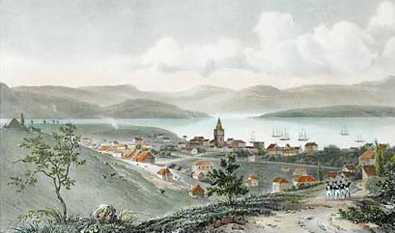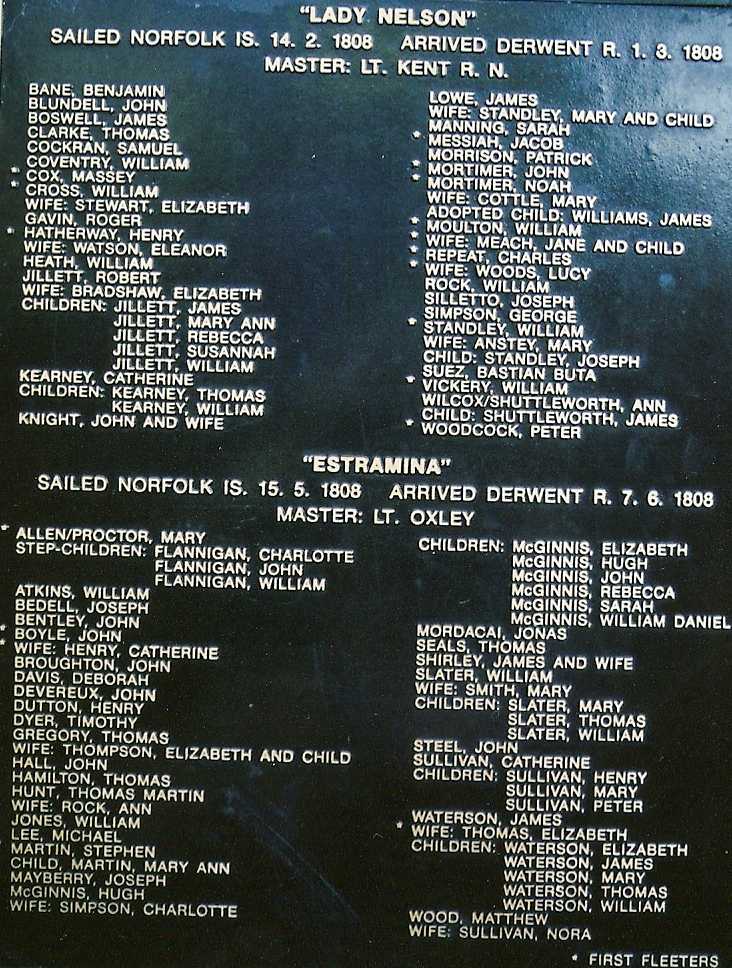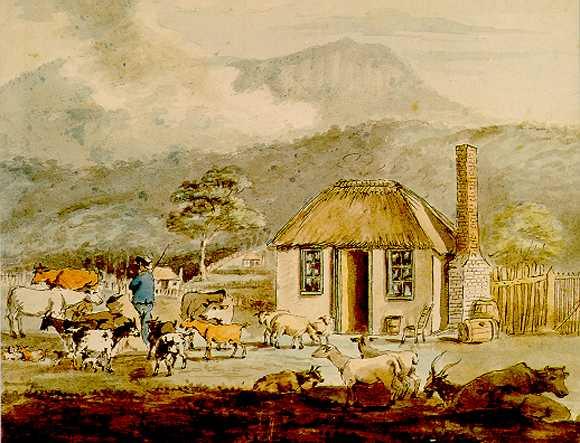
Robert and Elizabeth and 5 children sailed into Hobart from Norfok Island on the Lady Nelson in 1808.
One cannot imagine what that must have been like for the family, their possessions, and their sheep and pigs!
As a free settler Elizabeth was granted land in Hobart Town in lieu of the lands that she had left behind
on Norfolk Island.
By late 1808 they had built on land on the corner of Collins and Campbell Street, Hobart, at the rear
of the City Hall). This would probably have been a grant to Elizabeth in place of her Norfolk Island land.
It was later described in correspondence as her land.
(A large commercial building stands on the land now, in the medical prescinct)
Opposite them on the Hobart Rivulet in Collins Street (where the Royal Hobart Hospital now stands) a Mrs. Catherine Kearney
* (previous contributors alluded that she was a free woman, but that is incorrect) was granted land.
She also came from Norfolk Island with her two sons, William and Thomas.
The Bradshaw/Jilletts would probably have known her on Norfolk Island. Her grant was discovered with ti-tree
and convicts cleared it. She became known as the Dairy-woman of the Settlement and supplied the Government
and the officers with milk from her herd.
Not far from the Bradshaw/Jillett residence, at the end of Hunter Street was Hunter Island, it has since been filled in and joined up
near the I.X.L. Jones Jam Factory. This Island was the place where all the criminals were hung.
The house was in Wapping at that stage. Wapping was bounded by Campell, Park, Liverpool and Macquarie Streets. Park Street may have been the street in wich St. Davids Burial ground was.
Robert Jillett was resettled on land at Newtown in the country of Argylle. This was later called Friendly Farms. Elizabeth would have
brought her stock with her from Norfolk Island and probably Robert would have had this to start with for his farm. He was later
supplying stock to the Government Stores from Friendly Farms.
By 1801 when the settlers and convicts had been sent from Norfolks Island, the population of the south of Van Dieman's Land
was 1,000 people and in the north 277 people.
Robert Knopwood was the Minister for the south, but there was no Minister for the northern regions.
In 1811, when G.W. Evans, the Government surveyor was given the task of drawing up streets etc, it was found that the Bradshaw land was to be bi-sected by Collins and Campbell streets and it was found that one of the angles of the house projected onto Collins Street.
Thre was quite a lot of communication regarding this land and house, and eventually in 1827 the
Government decided to give 500 acres at Green Ponds (now Kempton) in compensation for the house
and land. Unfortunately that Grant has not been found as yet.
been surveyed at that time.
It is quite possible that the family may had had trouble with aborigines as they were trying to survive amongst the white settlers. Someone would have had to also stay with the cattle or sheep, for as well as having to contend with bushrangers, sheep stealers and aborigines, there were no fences and the animals would stray.
On March 1820 Robert Jillett signed a memorial to J.T.Bisse.
Aslo in 1820 he was supposed to have received a grant of 140 acres at Argyle (Newtown). This is possibly the Friendly Farms grant which had been measured as 160 acres and had ot been received, even though he had been in possession for some years. In most cases people were on their grandted lands and using them long before their actual piece of official document granting them the use of the land was received.
In 1823 he received a grant of 50 acres at Back River - 30 acres for himself and 20 extra as he was married. (Back River is now called Magnra).
Robert's two sons, William Bradshaw and James Bradshaw (they always retained the name Bradshaw, as given them at their birth, due to the fact that records in those days gave the surname of the woman to any children born out of wedlock. Some miraculous births occurred up to 7 years after the death of the husband!
Whilst living in Hobart, Elizabeth had several convict women to assist her. They included Ann Smallman a servant who could wash and iron She was assigned to Elizabeth in 1820, but only for a few months. She then married Edward Hale.
Mary James, she was assigned to Elizabeth again for only a few months, as on several occasions she appeared to be drunk and disorderly, and she was found in the house of John McKenna, in bed with a man named Sutherland!
Susan Sandford, she couldn't write, and was found absent without leave from her Mistress's premises, and sent to the factory for assignment.
Margaret Hill, she was a widow with two children, and she could cook, wash and get up linen. She left for striking her mistress! and was sentenced to 6 months in the House of Correction. She also had a further 36 appearances for drunkenness!
G.G.G.Grandaughter Maree De Graw
Was Elizabeth the first Free Woman Settler on Norfolk Island?
Was she also one of the first Free Women Settlers in Hobart?
*Catherine Kearney arrived on the Lady Nelson in 1808 from Norfolk Island, where she was listed as a dairy farmer. She was born in Ireland in 1769, and tried in 1791. She was transported to the Colony on "Marquis of Cornwallis" in 1796. Then to Norfolk Island in 1796 on the Reliance. She had a few husbands (partners) on Norfolk Island, but seems to have been with Roger Gavin when she returned to Hobart. He went to Norfolk in 1801, on the Chance, he was not the father of her 2 children who were born in 1798 and 1799. She must have been a "pardoned" convict by the time she arrived in Hobart.
Typical Wattle house
ARRIVING IN HOBART ON THE LADY NELSON 1808.
Elizabeth Bradshaw was one determined lady. Firstly she encountered all the hardships by following her husband on a death ship half way around the world to Botany Bay accompanied by her 2 year old daughter.
With her husband dead, and she a "free settler", Elizabeth might very well have been a lady worth pursuing.
Perhaps that is what Robert Jillett thought!
He became her "ward" then her partner, fathering two sons, then he worked in her businesses from 1799 until 1803, where once again he committed an offence serious enough to see him hang!
Instead of letting him go to Norfolk Island and face the consequences alone, she decides to sell everything and follow him. That surely speaks of her nature! Was it love? or was it her devotion to her young children?
One wonders what may have been if she had stayed on her large allotment in Sydney, and retained the lands on which the magnificent building known as Vaucluse House was later built.
So once again her strength overshadowed adversity and she prospered on her different allotments on Norfolk Island.
One thing to remember is that there was no currency at the time. Trade was done from the commandant's store in barter, or more often in rum. Currency was not introduced until 1817.
Robert and Elizabeth and 5 children sailed into Hobart from Norfolk Island on the Lady Nelson in 1808. One cannot imagine what that must have been like for the family, their possessions, their sheep and their pigs.
The sight could not be what she expected. After 5 years of living in a fairly warm climate, except for the chilling south eastern winds, she steps out into the cold clime of Van Diemen's Land. Tents became the home.





